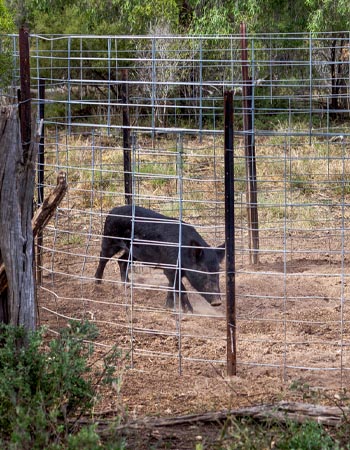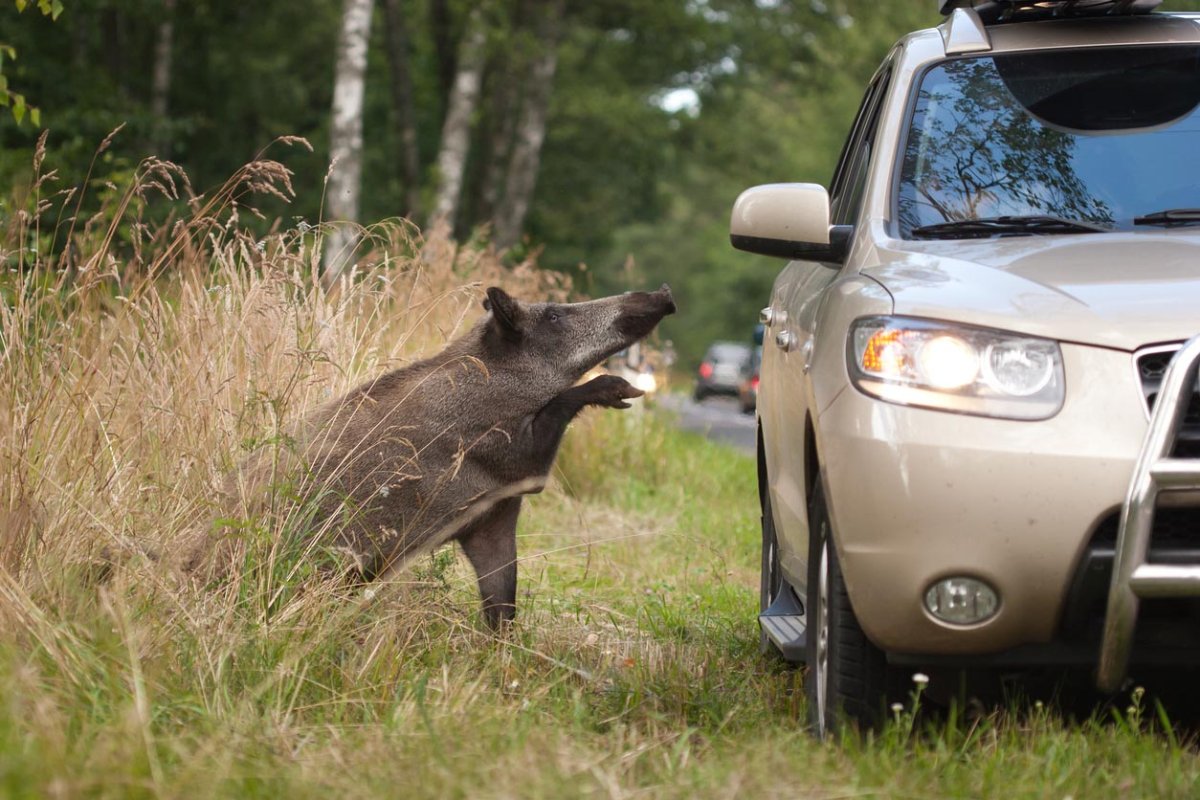

We may earn revenue from the products available on this page and participate in affiliate programs. Learn More ›
Project Overview
- Wild hogs are invasive in many parts of the U.S. and can cause significant damage to a property.
- Some signs of wild hogs are large sections of disturbed soil, droppings, hoof prints, and trampled ground.
- Methods for deterring wild hogs yourself include using repellents, cleaning or sealing up garbage and debris, installing security lighting or motion-activated sprinklers and ultrasonic devices, putting up fencing, and trapping.
- Wild hogs are persistent and potentially dangerous, so if DIY methods aren’t sufficient, it’s a good idea to enlist the help of a wildlife removal specialist.
Wild hogs, sometimes also referred to as wild pigs or feral swine, are not native to America and include descendants of formerly domesticated pigs, Eurasian wild boar, and the offspring of the two. As a non-native species, they compete with native animals for food and habitat and can create a nuisance for homeowners, leaving behind property damage by rooting (turning over soil to search for food), trampling, and leaving behind scat piles.
According to the United States Department of Agriculture (USDA), wild pig species are mostly found in southern states that range from Texas to Florida and the Carolinas, but they also live in most of California and other states as far north as Michigan. Wild hogs are managed with a combination of lethal and nonlethal strategies. Nonlethal methods like fencing and deterrents may be manageable for the average homeowner dealing with the occasional wild hog in the yard. However, if the problem persists, it’s a good idea to let one of the best wildlife removal services (like Critter Control or Trutech) implement more permanent solutions.
Tools & Materials
Bobvila.com may earn a commission from purchases made through these links.
Signs of Wild Hogs in the Yard

In some cases, you may wonder what animal is digging holes in your yard. But the answer will probably be obvious if that animal is a wild hog. Hogs, both wild and domesticated, use their snouts to rut, or dig up the ground, in search of food, “which creates a plowing effect of churned-up soil and ground cover vegetation, creating major natural resource impacts and property damage,” according to Christina Kontos, the environmental mitigation manager and wildlife biologist at Babcock Ranch, a planned community in Babcock Ranch, Florida.
Wild hog damage is difficult to repair and will require leveling the ground and reseeding it. Other signs that wild hogs have been in your yard include hoof tracks, scat, wallows (shallow holes in the ground created by hogs rolling in the mud), droppings, and trails where they travel.
Before You Begin…
David Heithoff is a Critter Control franchise owner in College Station, Texas. He says, “Before homeowners begin to tackle a wild hog problem, it is important that they research the dangers and potential damages a group (sounder) or a single hog can do.” Since hogs can be aggressive if they feel threatened, keeping a safe distance from these animals is imperative. The next step is to decide on how to get rid of wild hogs, depending on the resources and methods available. Wildlife removal costs typically fall between $191 and $611, but wild hogs present unique challenges, so it’s best to get an estimate from a wildlife removal specialist.
According to the Texas A&M Cooperative Extension, the average lifespan of a hog is 4 to 5 years, but while they have a high mortality rate, they reproduce quickly. In fact, in a 12- to 15-month period, feral sows can produce two litters of up to four to eight young per litter. This is one reason why control methods include lethal removal, including hunting and trapping for euthanization as common wild hog control strategies. But these strategies are best carried out by someone with training and experience.
Tips for Getting Rid of Wild Hogs
- Assess your property and decide which wild hog control method is best, and most doable, for you.
- Use multiple strategies, like keeping garbage cans covered, installing motion-activated lights, and applying wild hog deterrents.
- Leave wild hog hunting or euthanization to the professionals or those with experience.
Safety Considerations
- Wild hogs can be aggressive toward people when they feel threatened, so don’t approach them or feed them.
- If using a trapping method, make sure the trap is sturdy enough to contain the hogs.
- Hunting wild hogs and shooting wild hogs requires experience with firearms and a knowledge of local hunting regulations.
7 Methods to Keep Wild Hogs Out of Your Yard
There are a number of methods to reduce conflict with wild hogs and discourage them from coming onto your property. And while these methods can be effective, wild hog management will likely require the help of wildlife management services.
1. Spread repellents around the yard in areas where hogs have been spotted.
Spreading wild hog deterrents is a common method for preventing wild hogs from coming onto a property, although these products have varying results. One popular commercial deterrent is Wild Hog Scram, but some homeowners have found success with homemade solutions. Home remedies often include scents that hogs associate with humans such as cologne or tobacco. Another wild hog repellent option is predator urine, which can be purchased online or in a hunting goods store. The urine can be applied to the ground in any location where wild hog activity has been noticed to discourage them from crossing onto the property.

2. Keep outdoor garbage cans covered and remove any debris from the yard to avoid accidentally attracting hogs.
Wild hogs love to eat just about anything. While it isn’t practical to try to remove all of the bugs and roots in your yard that could be attracting hogs, keeping outdoor garbage cans covered and getting rid of any debris that could draw hogs in for a meal can be effective. If there are any bird feeders or pet food bowls out, even these can attract hogs. Hogs are also drawn to areas with lots of shade for shelter. Using one of the best brush cutters to remove tall grass and branches may make the property less appealing.
3. Turn on bright lights around the property to scare off wild hogs in the evening when they are most active.
Wild hogs are most active in the evening. Since human activity is reduced at night, this means that hogs may feel comfortable wandering onto a property that they wouldn’t enter in the daytime when people are around. Hogs have very good eyesight and tend to be sensitive to light, so turning on bright lights around the property can scare them off. You can also install motion-sensor lights in areas where the hogs enter the property to startle them off as quickly as possible. However, it’s worth noting that lights must be very bright to have an effect. This may be a problem for those living in neighborhoods since bright security lights may be disturbing to neighbors.
4. Install motion-activated sprinklers or ultrasonic devices to startle hogs away.
Ultrasonic devices emit a high-frequency sound that is out of hearing range for humans but may be unpleasant enough for wild hogs that they will be deterred from coming into the yard. The effectiveness of ultrasonic devices, however, is cause for some debate. Hogs are intelligent animals, so after they have experienced a sound several times they can discern whether or not it is a threat. Another, possibly more reliable, method is installing motion-activated sprinklers to startle the hogs and douse them with water when they are activated. This may be enough to get them to head somewhere else.

5. Install sturdy mesh or electric fencing to block hogs from accessing the yard.
One of the most reliable methods of getting rid of wild hogs is keeping them off your property in the first place. Installing sturdy mesh fencing will keep hogs out of the yard and reduce the likelihood that you’ll come into contact with them. For extra protection, electric fencing may be more effective. Installing hog panels can be time-consuming, so you can also hire one of the best fence companies near you to tackle the job. Fence installation costs range from $2.40 to $3.90 per square foot.
“Electric fencing (at least two strands that total 2 to 3 feet in height) can keep hogs out of small yards and gardens,” says Kontos. “Hog panel fencing between 24 [and] 32 inches tall is effective but costly to install and maintain.” If you go the electric fence route, make sure to choose one of the best electric fence chargers so the wild hogs continue to get a shock if they come too close. This will teach them to stay away from your property.
6. Set baited traps and relocate (or contact a professional to relocate) the hogs once captured.
Trapping is an option that may be best suited to homeowners with relatively large properties. If you choose to set baited traps, consult local wildlife regulations to see if there are any guidelines you need to follow. Hogs are attracted to lots of different types of food—their hunger can be their biggest weakness—and they are most attracted to shelled corn. For trapping wild hogs, Heithoff recommends a remote-triggered corral trap. “These traps,” he says, “are designed to catch the entire sounder and eliminate the risk of catching non-target wildlife, such as deer.” Once the sounder, or whole family, is trapped, then it’s best to contact a professional to relocate them or euthanize them.
7. DIY methods may only get rid of wild hogs temporarily. Contact a wildlife removal specialist for a more permanent solution.
For long-term hog removal, it’s best to contact the best wildlife removal service in your area. While DIY methods may work for a while, Heithoff estimates that “[Ninety percent] of our customers try themselves and fail before reaching out for professional help.”
Wild hog removal services employ professionals who are trained and well versed in hog removal methods, and Heithoff says that, “a hog itself is one of the smartest mammals, so sometimes we need to think outside the box in order to remove them from traps after capture.” Homeowners without adequate knowledge of wild hog behavior will likely have a difficult time removing them for good.
Angi
